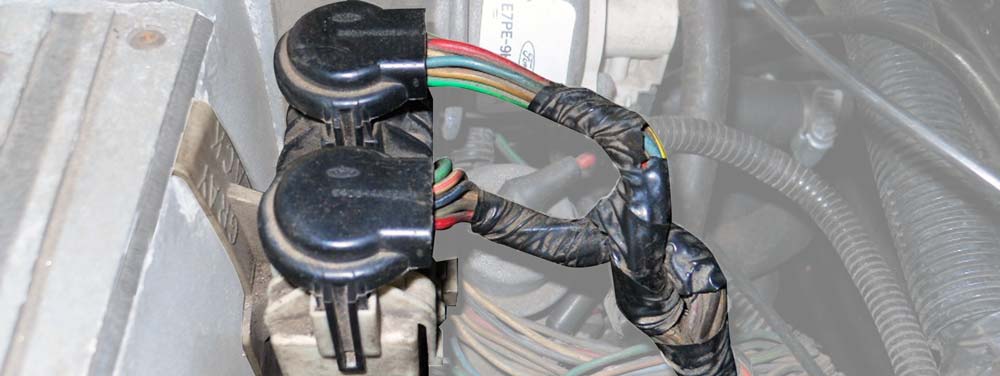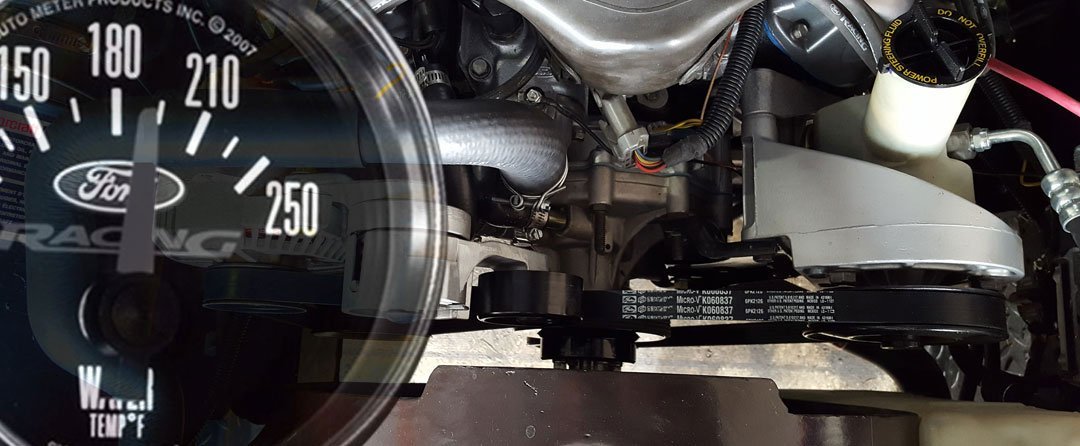Here’s a more comprehensive list of common problems related to the Foxbody Mustang surging idle. If you haven’t done so, check out the quick checklist >
Idle Air Controller (IAC)
Clean or replace the IAC (or IAB as some call it). This is a simple actuator that allows the computer to adjust air going through the throttle body (while the butterfly is closed) to keep the engine running at idle (roughly 700rpm). The controller uses 12v and has constant +12v power, the computer provides a ground (blue/light-blue wire) many times per second to open/close the actuator.
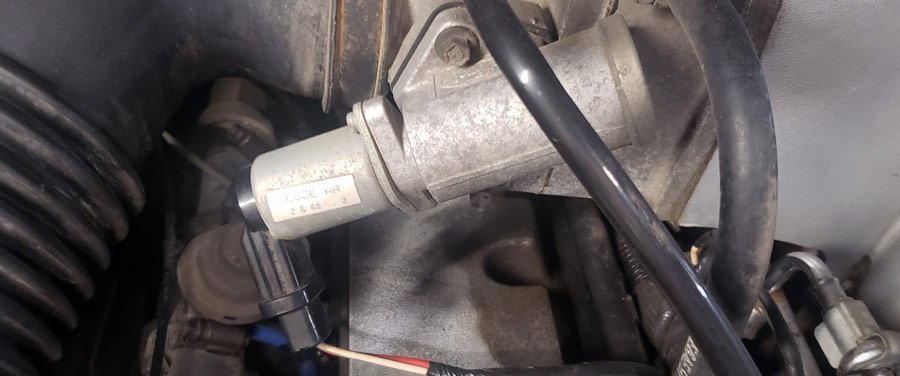
To troubleshoot:
- Look for +12 volt on the red wire (ground your voltmeter to the engine block). If the engine is running and there’s no voltage, you have bad wiring or connections.
- Measure the voltage between the red and blue/light-blue wires. You should see a reading between 0.5 volts to 12 volts (computer is turning on and off quickly, not varying the voltage). Without that reading, you may have bad wiring or connections.
- Check the resistance of the IAC terminals, it should read 10 to 14 OHMs between the two connections. Resistance should read open or greater than 1 Meg OHM between any of the connectors and the IAC itself.
Throttle Position Sensor (TPS)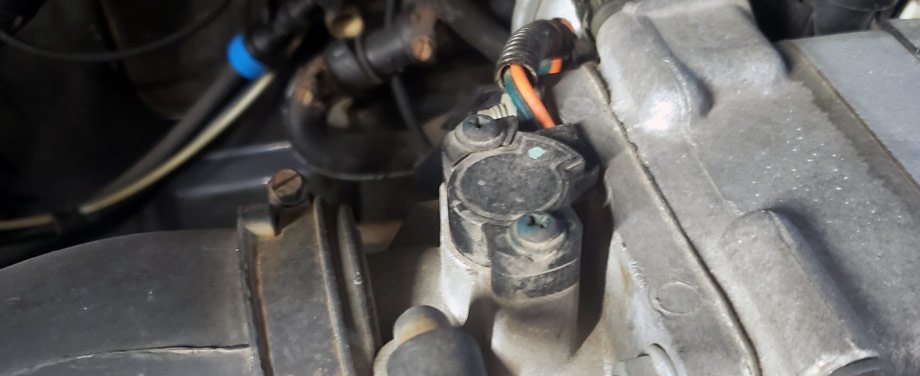
This is a potentiometer for the EEC (computer) to send a reference voltage and monitors the output voltage to determine precise throttle position. There is no magic setting for the TPS as the computer zeros out the TPS voltage each time it powers up. Instead you need to make sure the TPS isn’t out of range.
To troubleshoot:
- In most cases the computer will provide codes 23 or 63 for a failed TPS (not there is no guarantee it will send those failure codes).
- Codes could also be 58, 38, 19, 17, 13, 12 for the IAC
- Put the key switch to “run” position with engine off. Note the voltage with the throttle closed and slowly open the throttle and watch the voltage increase SMOOTHLY. Slowly release the throttle and watch the voltage again. Voltage should be smooth, not jumping around and shouldn’t vary much more than 10%. If you experience any of that, replace the TPS sensor.
Vacuum Leaks
Often forgotten but important to check. Fox Mustangs come with a lot of hard plastic vacuum lines that will crack with age. It’s always a good idea to check all vacuum lines and replace broken pieces. The Carbon canister is often a culprit of vacuum leaks.
Note: Some people recommend using things like carb cleaner to check for leaks (engine will speed up). However, it’s not recommended to spray flammable liquids onto a running engine in any circumstance.
Bad Oxygen Sensors (O2)
The HEGO sensors are used in closed loop operation of the EEC computer. When the 5.0 is running lean, the exhaust gas will have more oxygen so the O2 sensor will generate less voltage. If the engine is running rich, it will have less oxygen and the O2 sensor will produce a higher voltage. As the sensors age, the voltage range drops, and the voltage change lags the changes happening in the exhaust gas/oxygen. You typically want to change these sensors after 60,000 miles.

- Use pin 29 (left O2) or pin 43 (right O2) and the ground next to the computer ground. The individual O2 sensor should read between 0.20 to 0.90v at idle.
- The computer will throw codes 41 and/or 91 for possible O2 sensor failures.
Low Voltage at Idle
If you still have an aging 2G alternator in your fox, check your voltage at 1000rpm, it should be at 13.8 to 14.2 volts. Low voltage (below 13.2v required to keep the battery charged) can cause a plethora of problems. Underdrive pulleys may also aggravate the situation.
Note: If you have a 3G upgrade, be sure you have a ground upgrade (4GA min.) from the block to the chassis.
Dirty or Defective Mass Air Flow (MAF)
The MAF measures the mass of air going into the engine, measuring this helps compensate for air density changes with altitude and even the weather. Try and avoid an open-air filter element in the engine bay, it has been known to cause surging issues on some Fox Mustangs.

To troubleshoot:
- Measure the MAF output at the C & D pins on the MAF connector (dark-blue/orange and tan/light-blue wires). Measure voltage across the pins, not between pins and ground! You should see around 0.6v at idle.
- Check the resistance of the signal wiring from pin D on the MAF and pin 50 at the computer, you should see less than 2 OHMs resistance
- Check the resistance of the signal wiring from pin C on the MAF and pin 9 on the computer, you should see less than 2 OHMs resistance as well.
- For those with a cold air intake, try clocking the MAF by rotating the MAF to see If that helps.
Fuel Delivery System Problems
Be sure you don’t have a clogged fuel filter, dirty fuel pump sock (or underperforming fuel pump) or even damaged fuel lines. Poor fuel delivery will cause severe problems including surging idle.
Salt/Pepper Shakers

The salt/pepper shaker connections are used from the factory to speed up the process of manufacturing, they only had ONE job. It’s recommended to get rid of those by soldering the wires permanently which can prevent some strange, difficult to diagnose problems. Learn how to do it here >
Grounding Problems
This is a common issue, it’s always a good idea to ensure the electrical system is working properly and for that to happen, we need effective grounds. Here’s a link to help fix common ground problems.
- Battery to chassis
- Engine block to chassis (should be upgraded with 3G alternator)
- Computer to battery
Engine Coolant Temperature (ECT) and Air Charge Temperature (ACT) Sensors
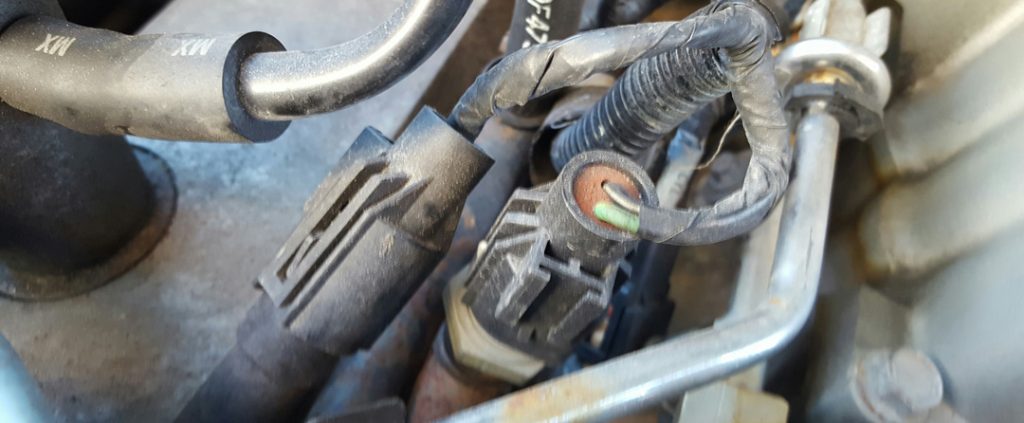
The ACT is located on the lower intake manifold (driver side), 5th intake runner. All it does is tell the computer what the air temperature is to help it determine the air density, it will provide extra spark advance if the air temp is cold enough. The ECT sensor tells the computer if the engine is essentially cold, warm or hot. Both sensors have the same thermistor, so the table values are the same.
To troubleshoot:
- Measure voltages across the two connector pins of the sensor connected and see if it’s within the range as described in the table below
| Degrees F | Voltage |
| 50 | 3.52 |
| 86 | 2.62 |
| 122 | 1.72 |
| 176 | .80 |
| 212 | .47 |
Defective Positive Crankcase Ventilation
Its original purpose was to allow an engine to operate underwater (originated during WWII). Today it’s used as an anti-pollution device. The PCV in your fox fits in a rubber grommet that plugs into the engine block at the rear of the lower intake manifold, hidden behind the upper. The rubber grommet is notorious for not fitting tight or sealing as it should.

To troubleshoot:
- Check the screen for clogs
- Ensure there aren’t any vacuum leaks by analyzing the grommet and vacuum hose
A/C Compressor
Check to ensure your compressor isn’t cycling on and off due to low charge and/or the cut-off switch is defective. To troubleshoot, unplug your AC compressor and see if it makes a difference.
More Reading
Check out our EFI sensors and thing article for a more in-depth look at how things work, as well as the SMOG article which is closely related to the systems controlling the 5.0.

